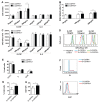miR-155 is associated with the leukemogenic potential of the class IV granulocyte colony-stimulating factor receptor in CD34⁺ progenitor cells
- PMID: 25730818
- PMCID: PMC4398671
- DOI: 10.2119/molmed.2014.00146
miR-155 is associated with the leukemogenic potential of the class IV granulocyte colony-stimulating factor receptor in CD34⁺ progenitor cells
Abstract
Granulocyte colony-stimulating factor (G-CSF) is a major regulator of granulopoiesis on engagement with the G-CSF receptor (G-CSFR). The truncated, alternatively spliced, class IV G-CSFR (G-CSFRIV) has been associated with defective differentiation and relapse risk in pediatric acute myeloid leukemia (AML) patients. However, the detailed biological properties of G-CSFRIV in human CD34(+) hematopoietic stem and progenitor cells (HSPCs) and the potential leukemogenic mechanism of this receptor remain poorly understood. In the present study, we observed that G-CSFRIV-overexpressing (G-CSFRIV(+)) HSPCs demonstrated an enhanced proliferative and survival capacity on G-CSF stimulation. Cell cycle analyses showed a higher frequency of G-CSFRIV(+) cells in the S and G2/M phase. Also, apoptosis rates were significantly lower in G-CSFRIV(+) HSPCs. These findings were shown to be associated with a sustained Stat5 activation and elevated miR-155 expression. In addition, G-CSF showed to further induce G-CSFRIV and miR-155 expression of peripheral blood mononuclear cells isolated from AML patients. A Stat5 pharmacological inhibitor or ribonucleic acid (RNA) interference-mediated silencing of the expression of miR-155 abrogated the aberrant proliferative capacity of the G-CSFRIV(+) HSPCs. Hence, the dysregulation of Stat5/miR-155 pathway in the G-CSFRIV(+) HSPCs supports their leukemogenic potential. Specific miRNA silencing or the inhibition of Stat5-associated pathways might contribute to preventing the risk of leukemogenesis in G-CSFRIV(+) HSPCs. This study may promote the development of a personalized effective antileukemia therapy, in particular for the patients exhibiting higher expression levels of G-CSFRIV, and further highlights the necessity of pre-screening the patients for G-CSFR isoforms expression patterns before G-CSF administration.
Figures








Similar articles
-
Inhibition of granulocyte colony-stimulating factor-mediated myeloid maturation by low level expression of the differentiation-defective class IV granulocyte colony-stimulating factor receptor isoform.Blood. 2000 Jun 1;95(11):3335-40. Blood. 2000. PMID: 10828013
-
Granulocyte colony-stimulating factor (G-CSF) treatment of childhood acute myeloid leukemias that overexpress the differentiation-defective G-CSF receptor isoform IV is associated with a higher incidence of relapse.J Clin Oncol. 2010 May 20;28(15):2591-7. doi: 10.1200/JCO.2009.25.9010. Epub 2010 Apr 20. J Clin Oncol. 2010. PMID: 20406937 Clinical Trial.
-
Detection of the granulocyte colony-stimulating factor receptor using biotinylated granulocyte colony-stimulating factor: presence of granulocyte colony-stimulating factor receptor on CD34-positive hematopoietic progenitor cells.Res Exp Med (Berl). 1992;192(4):245-55. doi: 10.1007/BF02576281. Res Exp Med (Berl). 1992. PMID: 1384092
-
Granulocyte colony-stimulating factor receptor at various differentiation stages of normal and leukemic hematopoietic cells.Leuk Lymphoma. 1997 Mar;25(1-2):37-46. doi: 10.3109/10428199709042494. Leuk Lymphoma. 1997. PMID: 9130612 Review.
-
Expression of G-CSF receptor on myeloid progenitors.Leuk Lymphoma. 2001 Nov-Dec;42(6):1351-7. doi: 10.3109/10428190109097763. Leuk Lymphoma. 2001. PMID: 11911419 Review.
Cited by
-
Neutrophil-Derived Microvesicle Induced Dysfunction of Brain Microvascular Endothelial Cells In Vitro.Int J Mol Sci. 2019 Oct 22;20(20):5227. doi: 10.3390/ijms20205227. Int J Mol Sci. 2019. PMID: 31652502 Free PMC article.
-
Granulocyte colony-stimulating factor impairs CD8(+) T cell functionality by interfering with central activation elements.Clin Exp Immunol. 2016 Jul;185(1):107-18. doi: 10.1111/cei.12794. Epub 2016 May 13. Clin Exp Immunol. 2016. PMID: 26990855 Free PMC article.
-
A review of granulocyte colony-stimulating factor receptor signaling and regulation with implications for cancer.Front Oncol. 2022 Aug 11;12:932608. doi: 10.3389/fonc.2022.932608. eCollection 2022. Front Oncol. 2022. PMID: 36033452 Free PMC article. Review.
-
Alterations in microRNA Expression during Hematopoietic Stem Cell Mobilization.Biology (Basel). 2021 Jul 15;10(7):668. doi: 10.3390/biology10070668. Biology (Basel). 2021. PMID: 34356523 Free PMC article.
-
miRNAs in acute myeloid leukemia.Oncotarget. 2017 Jan 10;8(2):3666-3682. doi: 10.18632/oncotarget.12343. Oncotarget. 2017. PMID: 27705921 Free PMC article. Review.
References
-
- Demetri GD, Griffin JD. Granulocyte colony-stimulating factor and its receptor. Blood. 1991;78:2791–808. - PubMed
-
- Touw IP, van de Geijn GJ. Granulocyte colony-stimulating factor and its receptor in normal myeloid cell development, leukemia and related blood cell disorders. Front Biosci. 2007;12:800–15. - PubMed
-
- Beekman R, Touw IP. G-CSF and its receptor in myeloid malignancy. Blood. 2010;115:5131–6. - PubMed
-
- Richards MK, Liu F, Iwasaki H, Akashi K, Link DC. Pivotal role of granulocyte colony-stimulating factor in the development of progenitors in the common myeloid pathway. Blood. 2003;102:3562–8. - PubMed
Publication types
MeSH terms
Substances
LinkOut - more resources
Full Text Sources
Other Literature Sources
Medical
Miscellaneous

